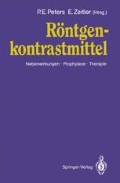Zusammenfassung
Wesentliches Merkmal der heute überall verfügbaren CT ist die Darstellung der Weichteile aufgrund des hohen Dichteauflösungsvermögens. Basierend auf dieser Eigenschaft ist in der CT die Distribution von applizierten Kontrastmitteln (KM) innerhalb der Kompartimente des menschlichen Körpers sensitiv darstellbar. Zur Erkennung und weiteren Spezifizierung unterschiedlichster Krankheitsbilder werden deshalb KM in der CT in großem Umfang eingesetzt. Ungeachtet der Applikation von oralen, hepatobiliären und intrakavitären (CT-Arthrographie, CT-Myelographie) KM, wird sich in den nachfolgenden Ausführungen auf die nephrotropen KM beschränkt.
Access this chapter
Tax calculation will be finalised at checkout
Purchases are for personal use only
Preview
Unable to display preview. Download preview PDF.
Literatur
Burgener FA, Hamlin DJ (1981) Contrast enhancement in abdominal CT: bolus vs. infusion. AJR 137: 351
Claussen CD, Banzer D, Pfretzschner C, Kalender WA, Schörner W (1984) Bolus geometry and dynamics after intravenous contrast medium injection. Radiology 153: 365
Hagman LA, Evans RA, Fahr LM, Hinick VA (1980) Renal consequences of rapid high dose contrast CT. AJR 134: 553
Heiken JP, Weyman PJ, Lee JKT, Balfe DM, Picus D, Brunt EM, Flye MW (1989) Detection of focal hepatic masses: prospective evaluation with CT, delayed CT, CT during arterial portography, and MR imaging. Radiology 171: 47
Katayama H, Yamaguchi K, Takashima T, Matsuura K, Kozuka T, Seez P: Adverse reactions to contrast media: ionic CM versus non-ionic CM. The Japanese Committee on Safety of Contrast Media
Mattrey RF, Long DM, Peck WW, Slutsky RA, Higgins B (1984) Perfluorocytylbromide as a blood pool contrast agent for liver, spleen and vascular imaging in computed tomography. J Comput Assist Tomogr 8: 739
McCarthy S, Moss AA (1984) The use of a flow rate injector for contrast-enhanced computed tomography. Radiology 151: 800
McClennan BL (1987) Low osmolality contrast media: premises and promises. Radiology 162: 1
Papahadjopoulos D (1979) Liposomes as drug carrier. Ann Rep Med Chem 14: 250
Schild H, Mildenberger P, Schweden F et al. (1987) Leber-CT mit portal-venöser Kontrastmittelgabe. Fortschr Röntgenstr 147: 623
Speck U, Mützel W, Weinmann HJ (1983) Chemistry, physicochemistry and pharmacology of known and new contrast media for angiography, urography and CT enhancement. In: Taenzer V, Zeitler E (eds) Contrast media in urography, angiography and computerized tomography. Thieme, Stuttgart, pp 2–10
Sugarbaker PH, Vermess M, Doppman JL, Miller DL, Simon R (1984) Improved detection of focal lesions with computed tomographic examination of the liver using ethiodized oil emulsion (EOE-13) liver contrast. Cancer 54: 1489
Vermess M, Adamson RH, Doppman JL, Girton M (1977) Computed tomographic demonstration of hepatic tumor with the aid of intravenous iodinated fat emulsion. Radiology 125: 711
Weinmann HJ, Felsenberg D, Müller H, Press WR, Römer T (1988) Kontrastmittel für die Computertomographie: Status und Zukunft. In: Claussen C, Felix R (Hrsg) Quo Vadis CT? Springer Berlin Heidelberg, New York Tokyo, S 367–377
Young SW, Noon MA, Nassi M, Castellino RA (1980) Dynamic computed tomography body scanning. J Comput Assist Tomogr 4: 168
Editor information
Editors and Affiliations
Rights and permissions
Copyright information
© 1991 Springer-Verlag Berlin Heidelberg
About this paper
Cite this paper
Claussen, C.D., Schmitt, R., Huppert, P. (1991). Kontrastmittelbedingte Nebenwirkungen in der Computertomographie. In: Peters, P.E., Zeitler, E. (eds) Röntgenkontrastmittel. Springer, Berlin, Heidelberg. https://doi.org/10.1007/978-3-642-76338-0_16
Download citation
DOI: https://doi.org/10.1007/978-3-642-76338-0_16
Publisher Name: Springer, Berlin, Heidelberg
Print ISBN: 978-3-540-53550-8
Online ISBN: 978-3-642-76338-0
eBook Packages: Springer Book Archive

